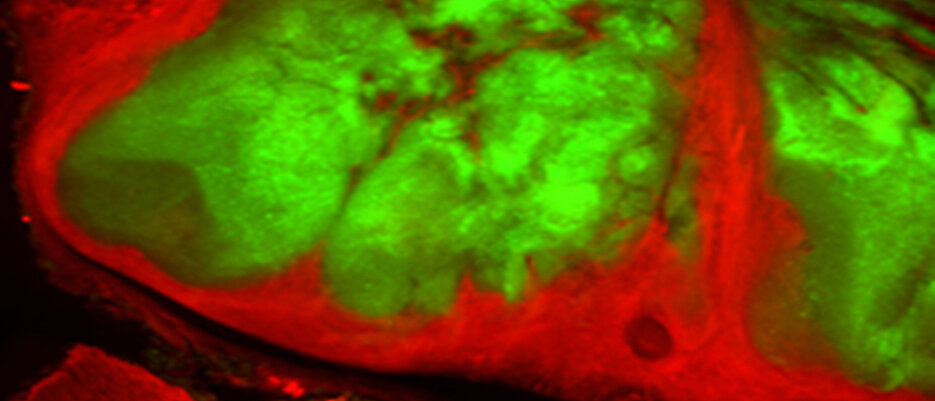Using viruses to attack cancer
10/17/2019Scientists at the newly established Cancer Therapy Research Centre of the University of Würzburg are working to develop new therapies to fight cancer. Their efforts get financial support from the Hope Realized Medical Foundation.

In the future, people who are diagnosed with cancer might be treated as follows: They get an injection of genetically modified viruses combined with special stem cells. Once inside the body, the stem cells transport the viruses selectively to the tumour tissue where they infiltrate the tumour cells. Subsequently, the viruses multiply, kill the cancer cells and additionally activate the body's immune system. Patients are cured after a short time and with little side effects. This novel approach of oncolytic virotherapy or oncolysis has already proven to be a powerful instrument to combat cancer in the laboratory and in animal experiments. First studies on humans have also delivered surprisingly successful results.
Scientists at the newly established Cancer Therapy Research Centre (CTRC) of the University of Würzburg are researching whether this kind of therapy could revolutionize cancer treatment in the future. For this purpose, they will receive up to five million euros worth of funding from the Hope Realized Medical Foundation over a period of five years. The CTRC is located at the Biocenter of the University of Würzburg. It is led by Aladár Szalay, a former professor at the Rudolf Virchow Center who is now a visiting professor at the Biocenter at the Department of Biochemistry. Professor Utz Fischer, who holds the Chair of Biochemistry, and Garry Nolan, a professor at Stanford University in California, are also on the managing board.
Successful trials on patients resistant to treatment
"Recent clinical studies have shown that viral therapy can be successful," says Aladár Szalay According to the scientist, the treatment worked even in patients who no longer responded to standard therapies. The Tübingen University Hospital, for example, reported about a year ago that viruses had killed the cancer cells in patients suffering from peritoneal cancer. The viruses used for this purpose were developed in the labs of Aladár Szalay's. The scientists from the CTRC believe, however, that this "virus-only" approach can be further improved by combining it with stem cells.
"Stem cells have a high affinity to inflammations and thus to tumours which makes them ideal vehicles to transport the viruses into the tumour cells like a Trojan Horse," Szalay says and he explains that even though the viruses are capable of finding their way on their own, the transport via stem cells is more effective. Moreover, this prevents the patients' immune system from taking notice of the viruses and fighting them.
A virus tried and tested for centuries
Looking for a new form of cancer therapy, the experts from the CTRC chose the Vaccinia virus which has been used extensively as a smallpox vaccine in millions of people with a well-documented safety profile for more than 200 years. The virus has other properties that make it interesting for treating patients: "It does not integrate with the genome of the tumour cells, i.e. it is not mutagenic, it destroys only the cells," the biochemist explains. What is more, infection is usually well tolerated by the patients. Virus-related symptoms such as fever or joint paint are only temporary in most cases.
Szalay and his team have already treated several thousand mice with human tumours with their combination therapy of viruses and stem cells. According to the scientist, this kind of treatment has been hugely successful: "None of the tumours came back afterwards". But he adds that there are still a lot of questions to be answered at the CTRC in the coming years. For example, the researchers want to test:
• how effective the different kinds of stem cells are
• which is the ideal combination of viruses and stem cells
• the particular dose
• the molecular biological differences between tumour cells, stem cells and tumour stem cells
Moreover, the scientists have yet to determine whether a single treatment scheme can be used for all types of cancer – regardless of the tumour type – or whether customised therapies are needed within the scope of personalised cancer immunotherapy. "We will have to test all this in the next years to find out which approach works best," says Aladár Szalay. The scientists are convinced that the method works in principle.
For detailed information on the progress of their research, see the following papers:
First-in-human study of TK-positive oncolytic vaccinia virus delivered by adipose stromal vascular fraction cells. Transl Med. 2019 Aug 19;17(1):271. doi: 10.1186/s12967-019-2011-3.
Delivery of oncolytic vaccinia virus by matched allogeneic stem cells overcomes critical innate and adaptive immune barriers. Transl Med. 2019 Mar 27;17(1):100. doi: 10.1186/s12967-019-1829-z.
Contact
Prof. Dr. Aladár Szalay, T: +49 931 31 84410, a.szalay_ctrc@uni-wuerzburg.de
Prof. Dr. Utz, Fischer, T: +49 931 31-84029, utz.fischer@biozentrum.uni-wuerzburg.de






